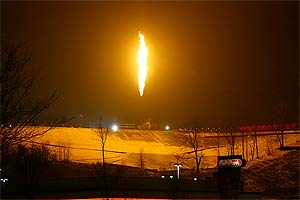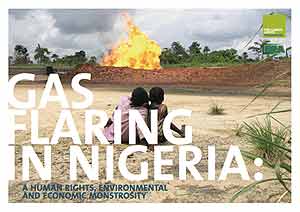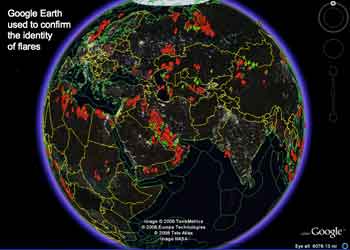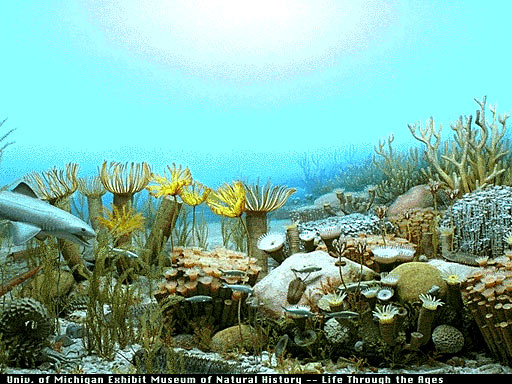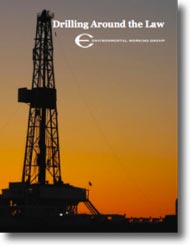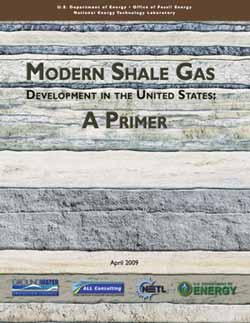Contains the keyword background
Learn how new drilling technology and rising fuel prices are driving the natural gas rush in Pennsylvania's Marcellus Shale—a 6,000 foot deep rock formation which has the potential to fuel the entire country for two full years.
This live, one-hour, call-in program on Thursday, May 22, 2008, offered viewers objective and reliable advice about:
- Natural gas exploration and drilling on leased land
- Lease negotiations and addenda
- Financial, environmental, and infrastructure impacts
WPSU: Gasrush
Landowner information on gas leasing in the Southern Tier. See: Tioga County Landowners Group.
Chesapeake Energy Flares Barnett Shale Gas Well in Trinity Trai, posted by TxSharon - Sharon Wilson - http://bluedaze.org
Poison Fire-The Movie below. Gas flares are visible from space.
"Whose woods these are I think I know"...
If you plan to stop by these woods on a snowy evening bring some marshmallows and expect an evening sunburn. There's a chance your treats will be toxic.
A recent study from Nigeria on mice associates flaring with respiratory and blood problems. Earlier studies from the Worldbank, the U.S., Canada, Climate Justice and a 2002 Schlumberger report note the importance of eliminating flaring to maintain fragile ecosystems and human health.
Why wait until there are deaths and illness to end industrial practices that waste money and human life? As long as the air or groundwater pollution doesn't clog their drill bits, gas industry engineers say these practices are safe.
Marcellus Protest posts an eyewitness account of gas flaring near a consumer shopping mall in Pittsburgh, where the noise and heat from a gas flare runs 24/7.
Can you see how Pennsylvania is starting to look more and more like Nigeria? (Neil Zusman, 2011-01-22.)
See: Anger grows across the world at the real price of 'frontier oil'
See: Fracking at the (Pittsburgh Mills Mall) | Marcellus Shale Protest 2011-01-10
Sharon Wilson of Bluedaze, Drilling Reform for Texase, recently had a "debate" on her YouTube posting, "Chesapeake Energy Flares Barnett Shale Gas Well in Trinity Trail," regarding flaring.
Sweet gas (natural gas that does not contain significant amounts of hydrogen sulfide) flaring has a longer history in Nigeria. According to the Daily Independent:
The Canadian Public Health Association (CPHA) has identified not less than 250 toxins from the gas flared from fossil fuels.
Film Synopsis
In 1956, Shell drilled the first oil well in the village of Olobiri, in the African Niger Delta. Since then, massive quantities of black gold have been pumped out of the ground there, and nobody seems to worry about a little spillage: lots of excess oil gets dumped or spilled, and gas flaring, or the burning of natural gas, takes place as well.
Poison Fire gives the floor to the inhabitants of the Niger Delta. No one sees anything positive in Shell's activities. Cancer, asthma, and miscarriages are all consequences of the pollution caused by the oil giant, and fish, slugs and snakes are dying out.
A group of environmental activists travel to Shell Headquarters in the Netherlands, where CEO Jeroen van der Veer politely addresses them at the entrance. He promises to launch a plan that will stop gas flaring, a practice that has been declared illegal by the Benin City Court. But how can the behaviour of a wealthy multinational realistically be corrected when Nigeria's own authorities are out-and-out corrupt?
 Friends of the Earth International website.
Friends of the Earth International website.
Read the report:
Environmental Rights Action, Friends of the Earth Nigeria. "Gas Flaring in Nigeria". Climate Justice. June 2005. (PDF 36 pp.)
See: Bluedaze Video. Chesapeake Energy Flares Barnett Shale Gas Well in Trinity Trail.
See: Chevron articles on Mixplex.
Daily Independent. "Enforcing the gas flaring deadline." Daily Independent. Lagos, Nigeria. August 9, 2010. Also available from the Norwegian Council for Africa.
See: The Case of Chevron.
See: World Bank. Gas Flaring Around the World. (2009). (Is the World Bank forever tainted by Lawrence Summers?).
A view of global gas flaring based on satellite observations: a joint effort between the US National Oceanic and Atmospheric Administration and the World Bank-led Global Gas Flaring Reduction partnership (GGFR)
See: Global Gas Flaring Identification in Google Earth
Download .kmz files for country of your choice. They will be addded to your Google Earth places. You can see the massive gas field with gas flaring adjacent to the Hobbs Public Schools and the Junior College in New Mexico.
See: Cooperative Institute for Research in the Environmental Sciences, University of Colorado. (CIRES)
Read these reports:
Elvidge, C.D. A Sixteen Year Record of Global Natural Gas Flaring Derived From Satellite Data. Earth Observation Group NOAA National Geophysical Data Center, May 18, 2010. (PDF)
Elvidge, C. D, D. Ziskin, K. E Baugh, B. T Tuttle, T. Ghosh, D. W Pack, E. H Erwin, and M. Zhizhin. “A Fifteen Year Record of Global Natural Gas Flaring Derived from Satellite Data.” Energies 2, no. 3 (2009): 595–622 (PDF).
Otitoloju, Adebayo, and Jemina Dan-Patrick. “Effects of gas flaring on blood parameters and respiratory system of laboratory mice, Mus musculus.” The Environmentalist 30, no. 4 (October 2010): 340-346. (free preview only)

"...And miles to go before I sleep"
Robert Frost. Stopping By Woods on a Snowy Evening (1923). New Hampshire
Nolan Hart. (2008). Includes photos, maps, illustrations.
Named for the town of Marcellus New York, where the shale reaches the surface, it is a Devonian age (roughly 390 million years old) member of a geological structure known as the Hamilton group. It formed when Devonian age seas...covered much of North America.
See the true cost of gas!
Natural gas is just another dirty fossil fuel. for more info see: Bluedaze
A [Barnett Shale] drilling rig operating for 3 months has the same impact as a city of 4,000 people—water use, solid waste generation, air emissions and traffic.
~David Burnett, Dir. Global Petroleum Research Institute
Dusty Horwitt. (2009). "Drilling Around the Law Report." Environmental Working Group. 24 pages.
Contains extensive bibliography.
Companies that drill for natural gas and oil are skirting federal law and injecting toxic petroleum distillates into thousands of wells, threatening drinking water supplies from Pennsylvania to Wyoming. Federal and state regulators, meanwhile, largely look the other way.
--The mission of the Environmental Working Group (EWG) is to use the power of public information to protect public health and the environment. EWG is a 501(c)(3) non-profit organization, founded in 1993 by Ken Cook and Richard Wiles. Includes the EWG Action Fund, a 501(c)(4) organization that advocates on Capitol Hill for health-protective and subsidy-shifting policies.
Joaquin Sapien and Sabrina Shankman. December 29, 2009 ProPublica.
Environmentalists, state regulators and even energy companies agree that the problem most likely to slow natural gas drilling in the Marcellus Shale in New York is safely disposing of the billions of gallons of contaminated wastewater the industry will produce...
...Of the six injection wells that operate in New York, only one is licensed to accept oil and gas wastewater. It's owned by Lenape Resources Inc., which uses it exclusively for wastewater from its own gas fields [near Rochester, NY].
See: Do the natural gas industry’s surface water withdrawals pose a health risk?

Joanne Fiorito, acting as the eyes of the DEP, recently discovered a waste spill at a drilling site just off RT 29 and upon reporting the spill was warned not to trespass.
"If the DEP can't monitor these sites on their own," said Ms.Joanne Fiorito "and then the DEP tells us that we cannot trespass after we found a spill on the Grimsley well pad site that wasn't reported to the DEP by Cabot, well then, where does this leave the citizens of PA who are dependent on the DEP doing its job?
It has gotten to the point where I and others will have to do it ourselves, and I personally don't care if they arrest me for civil disobedience, because this land, air and water is what keeps us all alive."
People Feel Threatened
Chesapeake Energy reports that citizens in Wetzel County, West Virginia have placed spikes along RT 89.
Pittsburgh Post Gazette reports that 161 species found killed along 38 miles of Dunkard Creek -- "Sudden death of ecosystem ravages long creek 'Everything is being killed': 161 aquatic species have died along Dunkard Creek" by Don Hopey, Pittsburgh Post-Gazette; September 20, 2009.
Earthworks' Oil & Gas Accountability Project works with tribal, urban and rural communities to protect their homes and the environment from the devastating impacts of oil and gas development.
See: Patrick Reis. NYT. Oct. 6, 2010. "W.Va. Sues Obama, EPA Over Mining Coal Regulations."
See also:
Wiseman, Hannah J. “Untested Waters: The Rise of Hydraulic Fracturing in Oil and Gas Production and the Need to Revisit Regulation.” Fordham Environmental Law Review 20 (2009): 115-170.
Horwitt, Dusty. "Drilling Around the Law: Drinking Water Threatened by Toxic Natural Gas and Oil Drilling Chemicals". Environmental Working Group, 2009.
The Primer provides regulators, policy makers, and the public with an objective source of information on the technology advances and challenges that accompany deep shale gas development and describes the importance of shale gas in meeting the future energy needs of the United States.
Protecting and conserving water resources is an important aspect of producing shale gas, and this effort was championed by the Ground Water Protection Council through a cooperative agreement with NETL.
U.S. Department of Energy (DOE), Office of Fossil Energy and National Energy Technology Laboratory. Modern Shale Gas Development in the United States: A Primer. Washington, D.C. U.S. Department of Energy (DOE). April 2009. 116pages. [PDF-5.11MB].
More than three decades after the Clean Water Act, iconic American waterways like the Chesapeake Bay and Puget Sound are in perilous condition and facing new sources of contamination.
With polluted runoff still flowing in from industry, agriculture and massive suburban development, scientists note that many new pollutants and toxins from modern everyday life are already being found in the drinking water of millions of people across the country and pose a threat to fish, wildlife and, potentially, human health.
In Poisoned Waters, Pulitzer Prize-winning journalist Hedrick Smith examines the growing hazards to human health and the ecosystem...
...In addition to assessing the scope of America's polluted-water problem, Poisoned Waters highlights several cases in which grassroots citizens' groups succeeded in effecting environmental change: In South Park, Wash., incensed residents pushed for better cleanup of PCB contamination that remained from an old asphalt plant. In Loudon County, Va., residents prevented a large-scale housing development that would have overwhelmed already-strained stormwater systems believed to contribute to the contamination in Chesapeake Bay.
See Credits.





